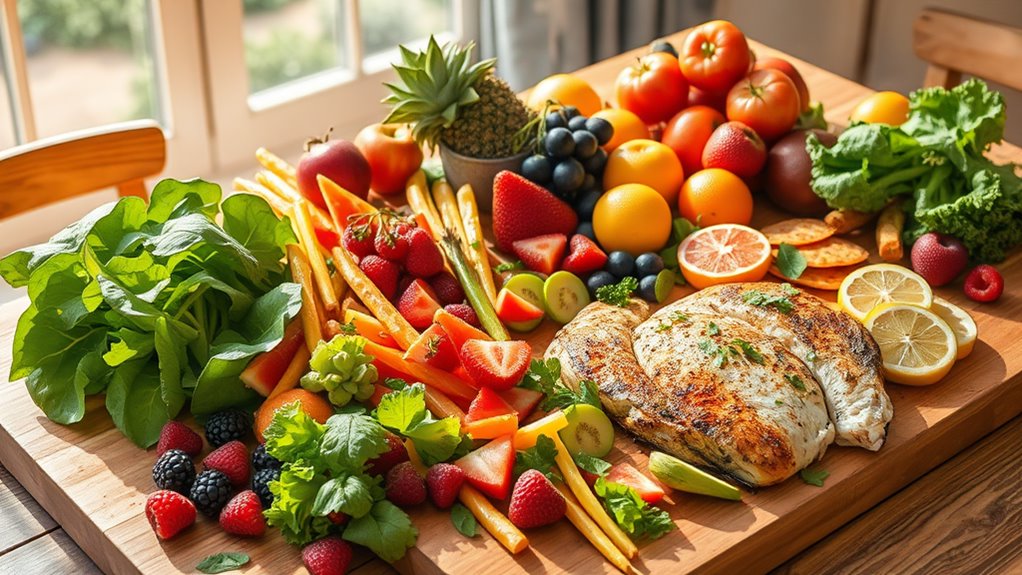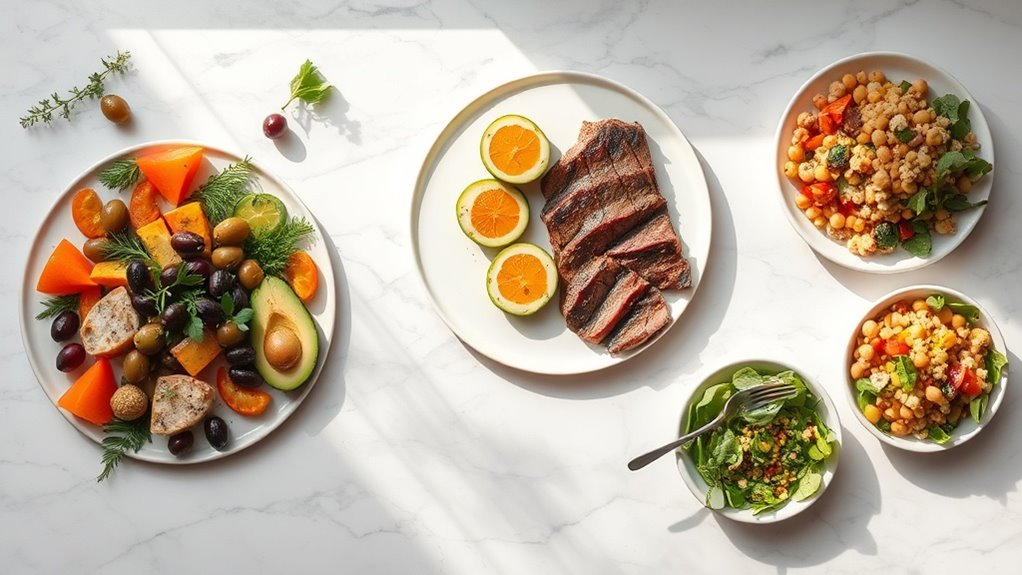The Best Diet That Doesn’t Feel Like a Diet
Imagine you’re a busy parent swapping fast food for quick, veggie-packed stir-fries that your family actually enjoys. This simple shift keeps you energized without the restriction of traditional diets, showing how balanced eating can become second nature. You’ll want to explore more ways to make these changes stick for good.
Principles of Sustainable Eating
When you’re exploring the principles of sustainable eating, you’ll build habits that support long-term health without strict rules.
A non-restrictive diet plan focuses on balance, encouraging you to choose whole foods like fruits, vegetables, and grains while allowing flexibility. Evidence shows that this approach boosts adherence, as you listen to your body’s signals rather than eliminating favorites.
Practically, track your intake mindfully, aiming for variety to meet nutritional needs without counting calories. This method promotes gradual changes, reducing the risk of burnout and fostering a lifelong, enjoyable relationship with food. Additionally, incorporating food journaling can enhance your awareness of eating habits and support your sustainable eating journey.
Benefits of Enjoyable Food Choices
When you choose foods you enjoy, you’ll notice an enhanced energy boost that keeps you active throughout the day. This strategy also improves your mental health by reducing stress and fostering a positive relationship with eating. Plus, it promotes sustainable weight control, helping you maintain results without constant deprivation. Additionally, mindful eating encourages you to savor each bite, enhancing satisfaction and enjoyment of meals.
Enhanced Energy Boost
Choosing foods you truly enjoy can ramp up your energy levels without the usual diet drag. When you select nutrient-rich options that excite your taste buds, like vibrant fruits or hearty whole grains, you’re fueling your body with sustained carbohydrates and proteins.
Studies show that enjoyment boosts adherence, leading to consistent intake of B vitamins and iron, which enhance cellular energy production. You’ll avoid the mid-afternoon slump by balancing meals with these choices, keeping blood sugar stable.
Practically, experiment with flavors to maintain variety, ensuring long-term vitality without deprivation. Stay mindful of portions for optimal results.
Improved Mental Health
Beyond just energizing your body, opting for foods you enjoy can uplift your mental health by fostering a positive relationship with eating. This reduces guilt and anxiety, as studies show pleasurable meals boost serotonin and dopamine, enhancing mood and emotional stability.
In practice, you can incorporate favorite flavors into balanced meals, like adding herbs to veggies, to make eating mindful and rewarding. Evidence from psychology research indicates this approach lowers stress and improves focus, without promoting extremes.
Sustainable Weight Control
While restrictive diets often lead to yo-yo weight fluctuations, enjoyable food choices foster sustainable control by encouraging long-term adherence.
You maintain weight more effectively when you select foods you love, like swapping fried snacks for grilled versions that still hit the spot.
Studies show that flexible eating patterns improve adherence rates, reducing the risk of regain while supporting metabolic health.
Practically, you experiment with balanced meals—think veggie-packed stir-fries or fruit-infused yogurts—to build habits that feel natural.
This approach keeps you motivated, avoiding extremes and promoting steady, realistic progress toward your goals.
Getting Started With Balanced Nutrition
Embarking on balanced nutrition means incorporating a mix of nutrient-dense foods into your daily routine, drawing from evidence like dietary guidelines from health organizations.
You’ll start by assessing your current eating habits, using tools such as food diaries or apps based on research from bodies like the WHO.
Aim for a plate that’s half vegetables and fruits, a quarter whole grains, and a quarter lean proteins, as studies show this supports health without restriction.
Track your progress with simple goals, like adding one new veggie daily, to build sustainable habits that enhance energy and well-being. Additionally, incorporating mindful eating practices can further improve your relationship with food and help you recognize fullness signals.
Creative Meal Ideas for Daily Life
As you explore balanced nutrition, creative meal ideas can transform everyday eating into an enjoyable adventure that sustains your energy and health.
Start your day with a vibrant smoothie bowl topped with berries, nuts, and Greek yogurt for antioxidants and protein.
For lunch, assemble a whole-grain wrap with hummus, turkey, spinach, and carrots, delivering fiber and vitamins.
Dinner might feature stir-fried tofu with broccoli, bell peppers, and brown rice, offering plant-based protein and minerals.
Keep snacks simple, like cucumber slices with tuna salad, to maintain steady energy without monotony, drawing from dietary guidelines for variety and satisfaction. Incorporating healthy fats like avocados into meals can further enhance flavor and promote satiety.
Tips for Maintaining Healthy Habits
Maintaining healthy habits doesn’t have to be overwhelming; you can build lasting changes by incorporating small, consistent actions into your routine.
Start by tracking your daily intake with a simple journal, which studies show boosts adherence. Set realistic goals, like adding one vegetable to each meal, to avoid burnout. Reward yourself non-food treats, such as a short walk, to reinforce positive behaviors. Food journaling cultivates mindfulness and accountability in eating habits, making it easier to stick to your goals.
Mix in variety to keep things fresh—alternate recipes to prevent boredom. Remember, habits stick when you link them to existing routines, like prepping veggies while watching TV, making them effortless and sustainable.
Strategies for Long-Term Lifestyle Changes
You build lasting habits by integrating small, repeatable actions into your daily routine, which research shows increases long-term success. Making gradual changes, like swapping one unhealthy meal for a healthier option, lets you adapt without overwhelming yourself. Together, these strategies help you create a balanced lifestyle that feels natural and sustainable. Additionally, meal planning can further support your efforts by reducing the likelihood of unhealthy snacking and takeout.
Form Lasting Habits
While temporary diets often falter, forming lasting habits demands evidence-based strategies that integrate seamlessly into daily life. You build sustainable routines by setting clear, achievable goals and leveraging behavioral science, like habit loops. Focus on consistency through daily cues and positive reinforcement.
| Strategy | Evidence-Based Support | Practical Application |
|---|---|---|
| Set SMART Goals | Research shows specificity boosts adherence (e.g., Locke & Latham studies). | Define goals like “walk 30 minutes daily.” |
| Use Habit Stacking | Studies indicate linking new habits to old ones increases success rates. | Add veggie prep right after breakfast. |
| Track Progress | Self-monitoring enhances accountability (e.g., via apps like Habitica). | Log meals and activities in a journal weekly. |
Make Gradual Changes
Embracing gradual changes fosters long-term lifestyle shifts by building on small, manageable adjustments that accumulate over time.
Rather than overhauling your diet abruptly, you start by swapping one unhealthy habit, like sugary sodas for infused water, which research from the Journal of the Academy of Nutrition and Dietetics links to better adherence.
You build momentum by tracking progress with apps, celebrating minor victories to avoid frustration.
This evidence-based strategy promotes balance, reducing dropout rates while allowing flexibility, so you adapt without feeling restricted or overwhelmed.
Consistency is key for lasting results.





